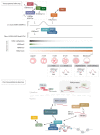The Molecular Impacts of Retrotransposons in Development and Diseases
- PMID: 38003607
- PMCID: PMC10671454
- DOI: 10.3390/ijms242216418
The Molecular Impacts of Retrotransposons in Development and Diseases
Abstract
Retrotransposons are invasive genetic elements that constitute substantial portions of mammalian genomes. They have the potential to influence nearby gene expression through their cis-regulatory sequences, reverse transcription machinery, and the ability to mold higher-order chromatin structures. Due to their multifaceted functions, it is crucial for host fitness to maintain strict regulation of these parasitic sequences to ensure proper growth and development. This review explores how subsets of retrotransposons have undergone evolutionary exaptation to enhance the complexity of mammalian genomes. It also highlights the significance of regulating these elements, drawing on recent studies conducted in human and murine systems.
Keywords: diseases; epigenomics; mammalian development; retrotransposons.
Conflict of interest statement
The authors declare no conflict of interest.
Figures


References
Publication types
MeSH terms
Substances
Grants and funding
LinkOut - more resources
Full Text Sources

